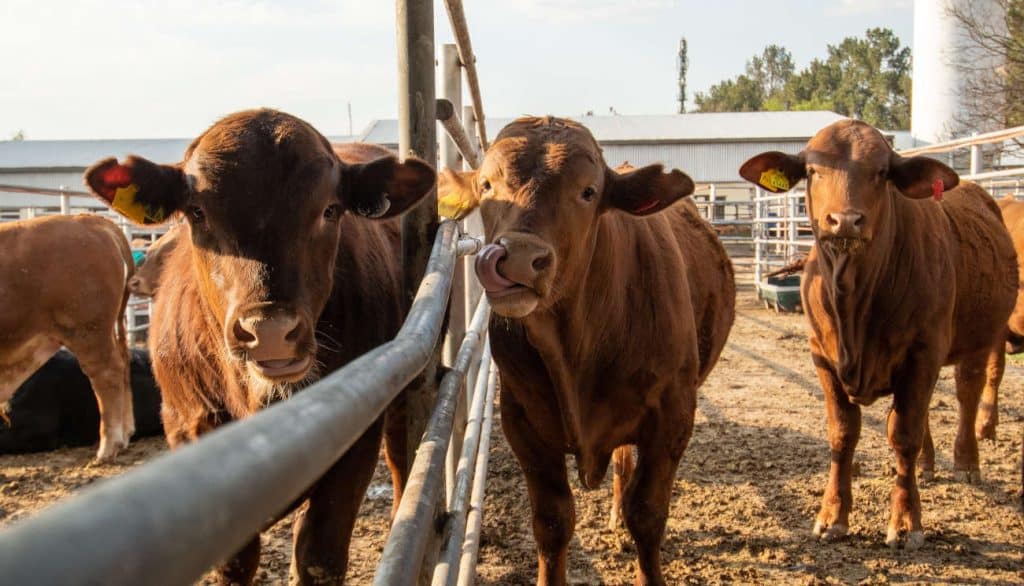Estimated reading time: 5 minutes
Animal handling involves techniques used by a handler to understand and respond to the inherent behaviour of livestock. These techniques have been fine-tuned over decades, as competent animal handling is an essential tool for productivity, meat quality and injury prevention for both the animal and the handler.
The goal of animal handling is to incorporate calculated techniques and safe handling facilities to reduce stress and promote welfare. In an intensive system such as a feedlot, cattle respond better to human interaction and are easier to manage in a low-stress environment. Thanks to Dr Johan Cloete, the students taking part in the UP-Agric Feedlot Challenge, hosted by the Department of Animal Science at the University of Pretoria, got to see and practice some of these techniques.
Good stockmanship
Many detrimental effects of animal handling are caused by a stress response in the animal. Good stockmanship begins with a calm demeanour and an understanding of a few inherent animal characteristics such as temperament, response time to novel stimuli, and response to restraint.
Temperament is a good indication of how an animal may react to handling. It is the result of genetics and the environment and is often influenced by previous experiences the animal has endured. The genetic component can be quantified by flightiness. For example, Bos indicus breeds tend to be more excitable than Bos taurus breeds.

Excitability and flightiness can often be associated with aggression, which requires quick and calculated responses from a calm handler to avoid any further stress in the animal. Furthermore, it is important to note that all breeds can be trained and accustomed to human interaction. However, this inherent characteristic should always be respected and anticipated – especially in unfamiliar environments.
Novel stimuli include loud noises, unfamiliar facilities or people, and foreign handling techniques. Cattle tend not to act immediately when threatened, but rather take a few seconds to decide how to respond or return to a familiar environment. Most importantly, stress-inducing stimuli should be avoided. However, some novel stimuli are unavoidable. Handlers should be aware of this characteristic of cattle and remain patient while interacting with an animal in these situations.
Cattle will avoid entering handling apparatus and become stressed if the operator can be heard but not seen. While an animal is being restrained, all the processing procedures should be done as quietly and orderly as possible. It is important to restrain animals with slow and steady movements, as restraining too quickly may induce stress.
The pressure of the restraint apparatus should only be enough to prevent the animal from moving within the apparatus and sustaining injury. No additional pressure should be applied to an animal that is struggling, as this may result in more stress or injury. If an animal is restrained too tightly, the pressure should be released slowly and smoothly. The facilities should also provide secure footing to avoid slipping and causing injury.
Animal handling techniques
Understanding animal behaviour can be complex. However, there are a few simple techniques that can help reduce stress in the animal and promote a positive handling experience.
Low-stress movement techniques need to consider vision angles and flight zones. Cattle have two distinct blind spots, one directly in front of their heads and the second directly behind them. A handler should always be within the vision angle and move in the opposite direction to that desired for the animal. Flight zones can be used to encourage and discourage animal movement.

If an animal is already facing the desired direction, pressure can be added by walking antiparallel to the animal within the flight zone. To stop the animal from walking, the handler can simply stop moving or release pressure by moving out of the flight zone. Lastly, to encourage the animal to turn around, the handler should add pressure by entering the flight zone at 45 degrees from the shoulder.
In intensive systems, moving cattle out of pens can be a stressful ordeal. Handlers should enter the pen through the gate, leave it open and use the same pressure techniques to encourage movement out of the pen.
Read more about erecting pens and camps.
How to improve your handling techniques
These techniques are essential for low-stress handling and can be further enhanced by working with more manageable group sizes, eliminating visual disturbances or any perceived threats during handling, and taking advantage of the following behaviour of cattle.
It is best to use low-stress techniques to encourage a positive handling experience from the outset. Cattle that have previously endured stressful handling will need more time to become used to these techniques. Nonetheless, low-stress animal handling is essential to improved productivity and animal wellbeing in all livestock operations. – Jody Young, MScAgric Production Physiology and Product Quality candidate, University of Pretoria
Read other articles in this series:
- Buying calves for a feedlot: What to look for
- The ins and outs of processing feedlot cattle
- Getting the best out of feed for feedlot cattle
- General feedlot management
- The importance of carcass quality in beef production


